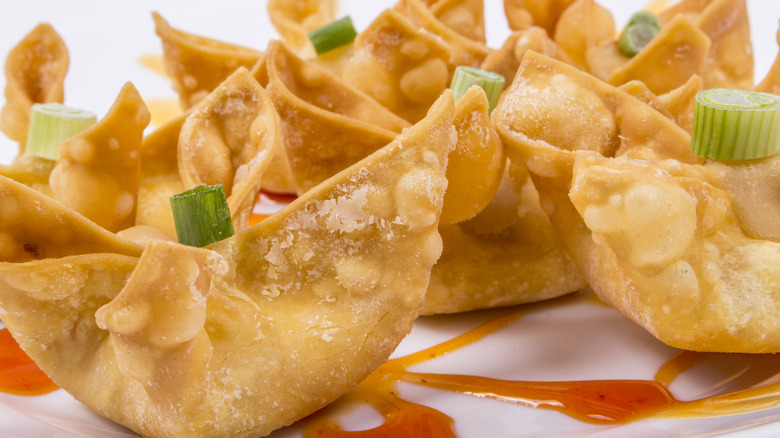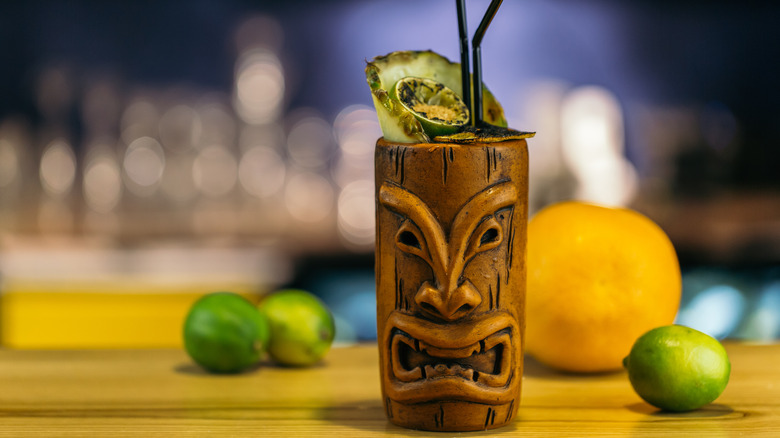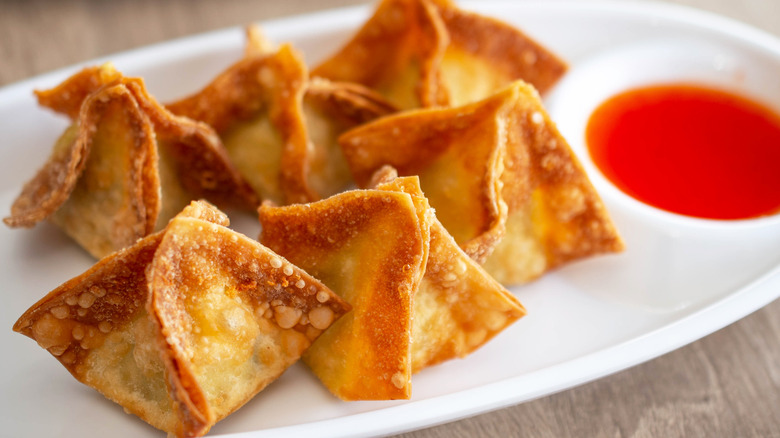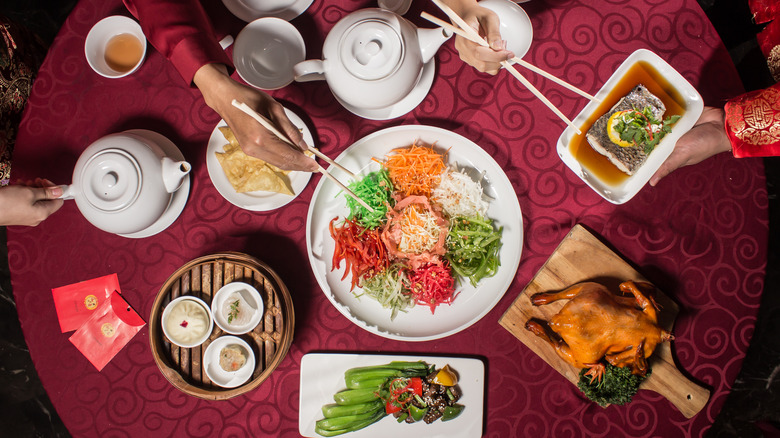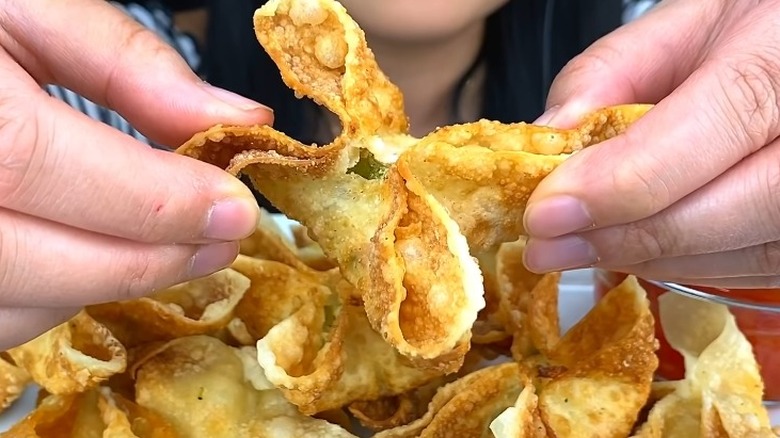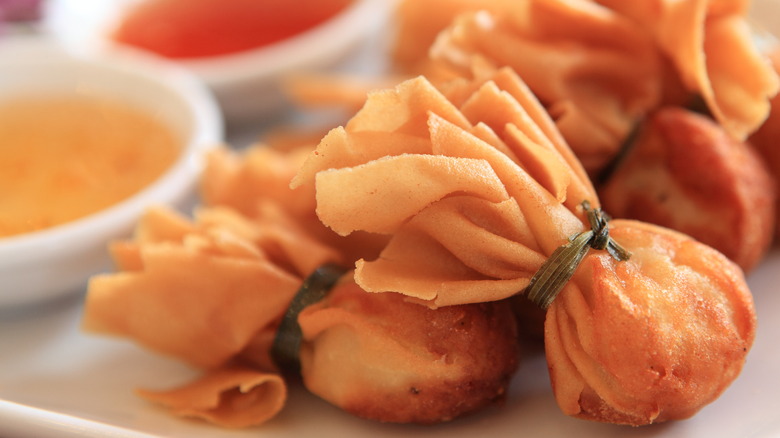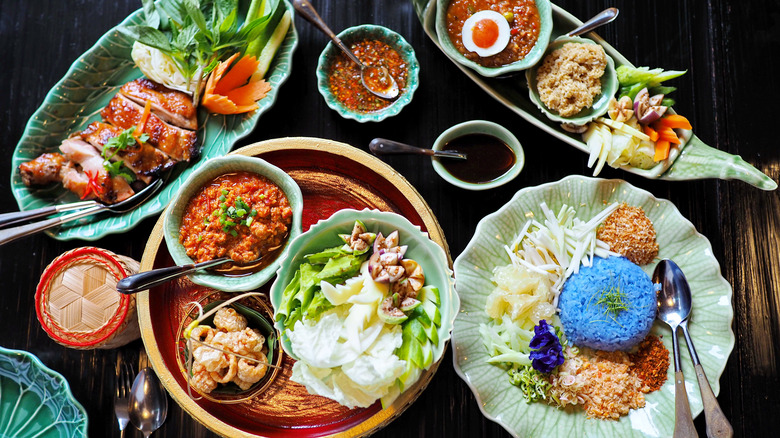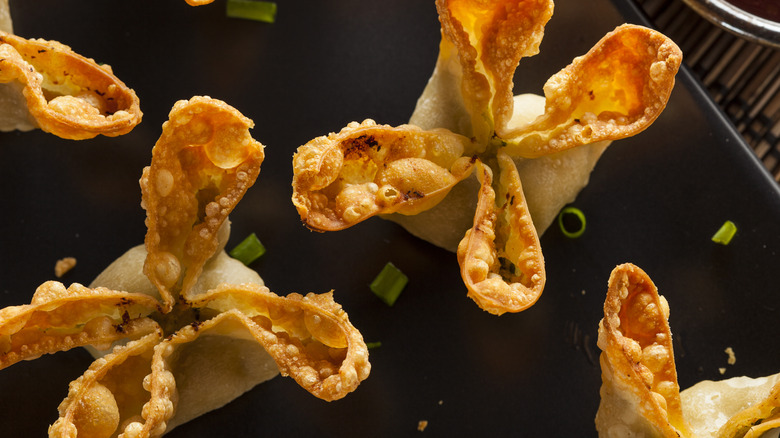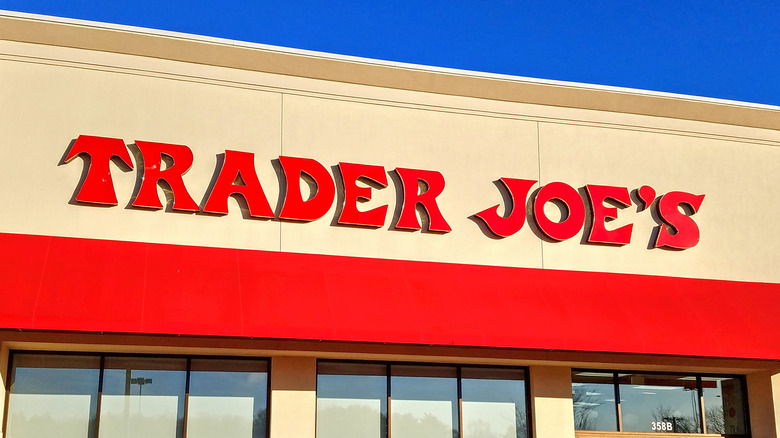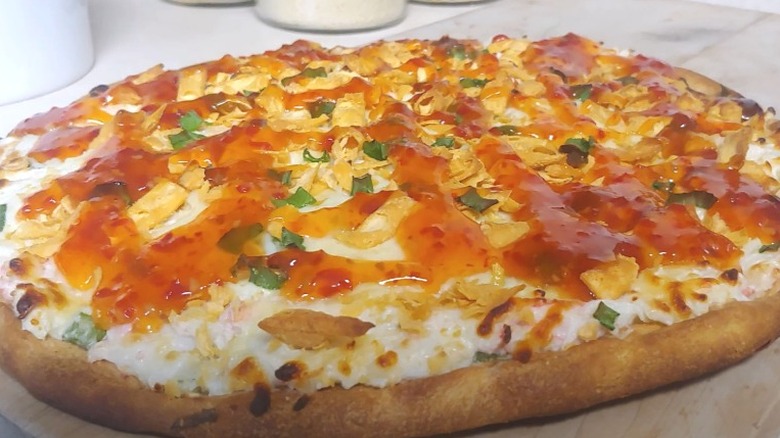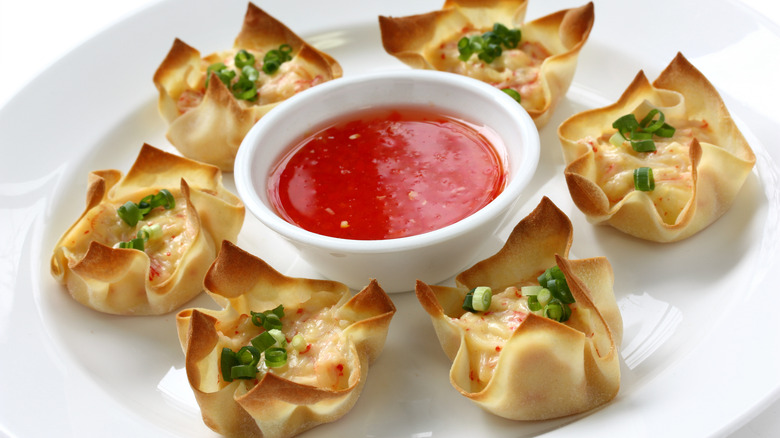The Truth About Crab Rangoon
Its hot, crunchy, rich decadence has graced the menus of restaurants for over 70 years. It makes TikToker foodies sing (via Today). An appetizer to some, an ecstatic experience to others, crab rangoon is a dish with a rich cultural heritage. This crispy cream cheese and crab stuffed wonton has been transmuted from a tiki bar experiment into the quintessential cocktail appetizer that foodies can't seem to get enough of.
The story of crab rangoon goes far beyond being a twist on a classic fried wonton. What's the dish on this creamy, crunchy American Chinese food that works so well at parties? And why has it made an unexpected resurgence on TikTok? Keep reading to discover the real truth about crab rangoon, because the answers might surprise you. For a dish that's available on Chinese menus in almost every region of America, its story is surprisingly murky and filled with myths.
It has its roots in tiki culture
Even though humans have been frying up food for centuries, crab rangoon isn't as old as you might think. In the 1940s, Americans became obsessed with the tropical, laid-back, island-style vibes associated with tiki culture. Veterans who had served in the Pacific theater in World War II returned home with a hunger for something that reminded them of their time in the Tropics (via ArcadiaPublishing.com). Tiki culture wasn't really authentic at all, but it sparked an interest in all things Polynesian.
According to Atlas Obscura, the most likely inventor of crab rangoon is Victor Bergeron, who founded Trader Vic's Tiki Restaurant and Bar, which opened in the mid-1930s and helped spark the tiki trend. Vic's granddaughter told the publication that he began experimenting with frying different ingredients in wonton wrappers sometime in the 1940s. The restaurant's version of the appetizer is a little different from the one you'll likely find at the Chinese takeout spot on the corner: it uses real crab instead of crab sticks and is seasoned with A1 sauce.
Rangoon is a city in Burma, but crab rangoon is not Burmese
Per Britannica, Rangoon, now known as Yangon, is the largest city in Myanmar (also known as Burma). It was once the Burmese capital. However, the name is the most Burmese thing about crab rangoon.
As Atlas Obscura points out, crab is definitely a protein consumed in Burma, but the dish's other main component, cream cheese, is a 19th century New York innovation. The name "Rangoon" just rolls off the tongue and makes the dish sound "exotic" to an American audience. There's no connection that ties the dish to the country of Myanmar.
While the name suggests otherwise, crab rangoon is as American as a cheeseburger. It's a blend of two mid-20th century American food trends: Americanized Asian food and cream cheese. Its name may be a lie, but crab rangoon's dubious origins don't take away the fact that the mix of cream cheese, crab, and seasonings tastes delicious when stuffed into a deep-fried, crunchy shell.
American Chinese food has a somewhat checkered past
While crab rangoon was technically created by an American restaurateur in the 1950s, it is still influenced by Asian-American culture and is a staple on American Chinese restaurant menus across the country.
The history of American Chinese food goes back to the late 1840s, when the Gold Rush brought in an influx of immigrants from all over the globe (via Library of Congress). In 1882, legislation was passed to make immigration more difficult, meaning fewer Chinese immigrants could come into the United States (via Archives.gov).
But there was a loophole that (thankfully) didn't get patched — the restrictive immigration laws allowed Chinese people to migrate to America if they were restaurateurs. Thus, the 1900s saw a major increase in Chinese restaurants (via Atlas Obscura). This is when Chinese cooks began to create the Americanized hybrid dishes we associate with American Chinese food today. The cuisine makes generous use of deep-frying and white sugar, both of which are essential for crab rangoon and its sticky-sweet dipping sauce.
It's trending on TikTok
Maybe for just this one trending topic, TikTok should be renamed Tiki-Tok. For whatever reason, crab rangoon is all over TikTok. While there's no definitive reason as to why this appetizer has suddenly achieved viral status — Delish writes that the hashtag #CrabRangoon has garnered over 112 million views as of January 2022 — there are a few plausible explanations. Perhaps people are drawn to crab rangoon because it's nostalgic comfort food. Maybe the original viral crab rangoon post appealed to viewers because Rangoon enthusiast Gabby Eniclerico crooned a little ditty about her favorite appetizer. Eniclerico herself thinks the appeal might relate to ASMR.
According to Sleep.org, ASMR (Autonomous Sensory Meridian Response) is a reaction that some people have to certain sounds. These sounds create an overall sense of well-being and contentment, which naturally helps us relax. The gentle crunching of a crispy crab rangoon may generate an ASMR response in viewers.
For whatever reason, crab rangoon has made a modern-day resurgence thanks to social media videos.
Crab rangoon often doesn't contain any crab
Per Atlas Obscura, most restaurants' versions of crab rangoon don't really contain crab at all (though the original Trader Vic's version does). They contain imitation crab, alias surimi, which is just white fish (usually pollock) that's been ground into a paste and mixed with starch, sugar, flavorings, and preservatives. It's then formed and dyed to look like crab leg meat (via SeafoodNutrition.org).
While it sounds rather unappetizing, it actually tastes pretty darn good. If you've ever had a California Roll at your local sushi establishment, then you've probably eaten imitation crab. It's also significantly cheaper than real crab meat, so we can see why it would appeal to restaurant owners.
Substituting fake crab for the real thing isn't the only modification some restaurants make to the original formula. Panda Express eliminates the seafood entirely to make something it calls cream cheese Rangoon.
Cheese is pretty much non-existent in traditional Southeast Asian and Chinese cuisine
It's already been established that crab rangoon was inspired by Polynesian and Asian foods, with a little bit (okay, a lot) of American influence. Perhaps the most American thing about crab rangoon is the cream cheese. If you look at the different food groups in Asian cultures and compare them to the American diet, you'll notice something missing: dairy.
Thrillist reports that the lack of cheese in Asian (particularly Chinese) food is due to historical factors. For one, the people who did historically eat cheese in China were nomadic cultures who lived outside of mainstream Chinese society. Furthermore, in most of China, livestock were being put to work as draft animals and didn't have the luxury of lazily grazing and producing milk. This cultural aversion to dairy also translated into physical problems with dairy consumption. The majority of Asian people do not have the gene that gives humans the ability to digest lactose as adults (via ScienceABC.com).
It's pretty easy to make
Our crab rangoon recipe is a pretty easy dish to cook up — actually, fry up. All you need is wonton wrappers, cream cheese, imitation crab (also called surimi), scallion (green onion), garlic, and soy sauce. If you want to get fancy, you can always use fresh lump crab meat. The only ingredient that might be a little hard to find in a conventional grocery store is the imitation crab, although according to InstaCart this product is usually available in grocers that sell seafood. It might be sold next to the other seafood or in the freezer section.
If you don't feel like heating up a huge pot of boiling oil to make crab rangoon at home, there are alternatives. This recipe from the Food Network uses an air fryer. Another relatively healthy and easy option is to bake your Rangoons (via Food.com). Whichever method you choose, you can count on one thing: They'll be delicious no matter what.
It has connections to Trader Joe's
Trader Joe's and crab rangoon have similar roots. How so? The tiki-island atmosphere that is a trademark of Trader Joe's was actually inspired by Trader Vic's. The grocery chain's curator, Joe Coulombe, had originally started a small grab n' go convenience store in 1958 called Pronto Market (via The Daily Meal). But competition from another convenience store chain — 7-Eleven — was threatening to put Coulombe out of business. Realizing that there was an interest in unique and healthy foods, he changed course and rebranded, and in 1967, the first Trader Joe's was born.
The grocery store's name was inspired by the opening of Trader Vic's flagship location in Beverly Hills in 1958, and also by the Pirates of the Caribbean ride at Disneyland, which opened in July 1955 (via KCRW).
The connection doesn't stop with Trader Vic's. TJ's also sold frozen versions of Edamame Rangoon and Crab and Langostino Rangoon.
There are different riffs on this beloved appetizer
People love fried cheese, and that's pretty much what crab rangoon is — a deep-fried wrapper filled with cheese (and other stuff if you want to get all fancy). Fried foods and cheese are comforting. This type of food is nostalgic, it makes us happy, and it also puts us into food comas.
Crab rangoon is a familiar template that people can use to make their own cheesy comfort food creations. Lox Rangoon, which substitutes smoked salmon for the crab sticks, is one great example. We all know how well cream cheese and salmon go together. Americans also love dairy-based party dips — pimento cheese, spinach artichoke, French onion. Why not crab rangoon? HuffPost reported the favorite Super Bowl dip for each state, and Connecticut's was crab rangoon dip. If you're looking for more than an appetizer, the test kitchen at Allrecipes has created an impressive — and rather unusual — take on this bite-sized crispy appetizer: crab rangoon pizza.
It has its own holiday
In 2009, as a response to being alone on Valentine's Day, a small circle of friends decided to create an unofficial holiday that would celebrate friendships, get-togethers, and inclusivity (via NationalToday).
Every February 13th, this crab-static holiday celebrates everyone's favorite Chinese takeout hors-doeuvre. Those who wish to participate — you don't have to be single, either — can use whatever recipe they like to cook their own crab rangoon with friends.
Cooking in general is a nice bonding experience. You have to communicate and work as a team (or you can watch while one person does all the dirty work — no judgments). It's just nice to be around people you care about while having fun making something as rich and delicious as crab rangoon. If you think about it, anything related to food, friends, and get-togethers seems like it would only have a positive impact on your mental well-being. So why not try to celebrate the holiday when it comes rolling through next year? You can even use the special hashtags (#NationalCrabRangoonDay or #CrabRangoonDay) to connect with other crab rangoon lovers around the world.
